Inspection for a forestry harvester needs a detailed checklist
Our team has created a 60-point checklist for forestry machine inspections. This list helps our inspectors ensure that nothing is overlooked during an inspection. The list guides them step by step through the inspection process. We provide detailed information about:
- Basic Machine information
- Operator Station details and condition
- Engine information and condition
- Condition of Exterior (chassis, sheet metal, paint)
- Condition of hydraulic system (pump, performance, hydraulic lines and cylinders)
- Condition of boom and mast
- Condition of harvesting aggregate
- Condition of Tires, axels and final drives
- Functional test
- Comments and recommendation for repairs
- Transport dimensions
See a sample of a report below. Please note: This is not the latest version. On request we can send a PDF-version of such a report.

What extras can you order?
Once you receive an offer it will be always for a basic walk-around with functional check. This level is called TA1. On our Checklist-Options page you can find additional services which you can order. We can check oils and pressures.
Oil sampling for engine and hydraulic system
On forest equipment with uncertain history it can be reasonable to take oil sampling. Our inspector takes oil samples from engine, transmission and hydraulic system. Also it would be possible to open final drive oil plugs to look for shavings. Please ask the team for detailed pricing.
If you have other questions about the service please contact the team by Whatsapp or by phone +493520639150. We are happy to answer in detail.
Pictures and video coming with a Mevas-Report
Each machine inspection comes along with 60-100 pictures and in some cases with a short video.

Inspections for other forestry equipment
We are an inspection service for all kind of heavy machinery. This includes forest harvesters, forwarders, skidders, log handlers and all other machines with an engine and a hydraulic system.
Video about excavator inspection by Mevas
For some kind of machines we made a video about the inspection process. For an excavator inspection a video it is available on our YouTube-Channel. (link bitte ersetzen)
Other sample reports heavy machinery
Visit our overview for other sample inspection checklists for heavy machinery.
Keep in mind: Report forms are our legal property and copying is a violation of our copyright.
What is a forestry harvester, what are the main components and which items should be checked during the inspection of a used unit?
A forestry harvester is a specialized piece of heavy equipment used in logging operations to efficiently fell, delimb, and cut trees to specific lengths. It is a core machine in mechanized logging, designed for speed, precision, and operator safety, particularly in commercial forestry applications.
🔧 What Is a Forestry Harvester?
A forestry harvester combines a base machine (often a purpose-built vehicle or modified excavator) with a harvesting head mounted on a boom. The harvesting head performs several tasks:
- Felling trees
- Delimbing the trunk
- Measuring the stem
- Cutting to desired log lengths
They are often used in conjunction with a forwarder, which transports the processed logs out of the forest.
🔩 Main Components of a Forestry Harvester
- Base Machine
- Engine (diesel-powered)
- Chassis or undercarriage (wheeled or tracked)
- Cab (usually reinforced and climate-controlled for operator safety)
- Boom and Arm
- Hydraulic boom for reaching and maneuvering
- Knuckle boom or telescopic arm depending on design
- Hydraulic System
- Powers the boom and harvesting head
- Includes pumps, hoses, valves, and cylinders
- Harvester Head
- Felling mechanism (chainsaw or circular saw)
- Feed rollers (to grip and pull tree through)
- Delimbing knives (removes branches)
- Measuring system (for length and diameter)
- Control System
- On-board computer for log measuring and bucking optimization
- GPS and telemetry (in modern units)
✅ Items to Check When Inspecting a Used Forestry Harvester
1. Engine & Powertrain
- Hours on the engine
- Oil leaks or contamination
- Air filters, belts, coolant condition
- Cold start performance
2. Hydraulic System
- Leaks in hoses, fittings, or cylinders
- Smooth operation of boom and head
- Hydraulic pressure and temperature readings
- Pump noise or unusual behavior
3. Boom and Frame
- Weld integrity and structural cracks
- Play or looseness in joints and pins
- Alignment and travel of the boom
4. Harvester Head
- Condition of feed rollers (wear, grip quality)
- Delimbing knives (sharpness, cracks)
- Chainsaw or blade (sharpness, chain tension)
- Sensor and measuring system calibration
5. Cab and Controls
- Control system responsiveness
- Display functionality and error codes
- Visibility, seat condition, climate control
6. Electrical System
- Battery health
- Sensor and ECU diagnostics
- Lights, alarms, camera systems
7. Undercarriage or Wheels
- Track or tire wear
- Drive motor performance
- Suspension (if applicable)
8. General Condition
- Rust or corrosion, especially in frame and boom
- Maintenance records (check intervals and major repairs)
- Signs of abusive use or poor storage
📝 Bonus Tip:
Always ask for a cold start, check how it operates under load, and try to observe it working with actual trees if possible. Bring a technician or mechanic familiar with forest machinery to evaluate the condition.
Would you like a downloadable inspection checklist in PDF or Excel format?

